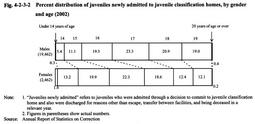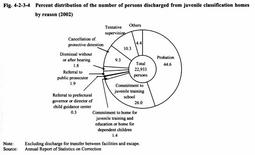| Previous Next Index Image Index Year Selection | |
|
|
2 Admission and discharge Fig. 4-2-3-1 shows the trends in the number of persons newly admitted to juvenile classification homes since 1949.
Fig. 4-2-3-1 Trends in the number of persons newly admitted to juvenile classification homes (1949-2002) The number of newly admitted juveniles showed a downward trend from 1985 until 1995, but turned upwards in 1996. In 2001, the number exceeded the total number in 1984, which was the peak for the number of persons newly admitted to juvenile classification homes during the period known as the third wave of juvenile delinquency in the postwar era. In 2002, the number decreased by 211 (0.9%) from the previous year but still exceeded the total number at the above-mentioned peak (see Appendix 4-10 ).Fig. 4-2-3-2 shows the percent distribution of juveniles newly admitted to juvenile classification homes in 2002 by age, by gender. Females are more likely to be admitted at a younger age compared to males. Fig. 4-2-3-2 Percent distribution of juveniles newly admitted to juvenile classification homes, by gender and age (2002) Fig. 4-2-3-3 also shows the percent distribution of juveniles newly admitted to juvenile classification homes in 2002 by type of delinquency, by gender. The distribution of larceny is the highest for delinquent Males in every age, followed by bodily injury, extortion and status offenses for junior juveniles, and Road Traffic Law violations, bodily injury and extortion for both intermediate juveniles and senior juveniles. As regards delinquent females, status offenses had the greatest share for junior juveniles and intermediate juveniles, followed by bodily injury and larceny for junior juveniles, and larceny and bodily injury for intermediate juveniles in that order. As for senior juveniles, the percentage of Stimulant Drug Control Law violations was the highest, followed by larceny. As juveniles get older, the percent distribution of status offenses decreases while that of Stimulant Drug Control Law violations increases.Fig. 4-2-3-3 Percent distribution of juveniles newly admitted to juvenile classification homes, by gender, age group and type of offense (2002) Fig. 4-2-3-4 shows the number of persons discharged from juvenile classification homes in 2002 by reason. Probation was the most common reason for discharge from juvenile classification homes, followed by commitment to a juvenile training school, and tentative supervision. Examining the number of persons referred to public prosecutor, it was 304 in 2000, but was 374 in 2001 when the Law for Partial Amendment to the Juvenile Law, etc. was enforced, and was 433 in 2002, showing an increasing trend.Fig. 4-2-3-4 Percent distribution of the number of persons discharged from juvenile classification homes by reason (2002) |



